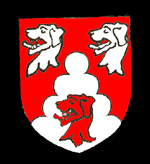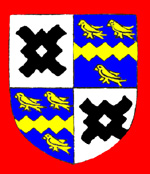Battlesden Manor
Volume III of The Victoria County History for Bedfordshire, published in 1912, gives a detailed account of the Manor of Battlesden. The Domesday Book of 1086 records that nine of the eleven hides in Battlesden were held by Walter Giffard. His tenant was Richard Talbot and in 1179 Hugh Talbot held Battlesden for one knight's fee, in other words, he had to provide a knight for service in the royal army. Instead of being tenant, like his ancestro, was was clearly the overlord. William Talbot was overlord in the early 13th century and, after his death, the overlordship passed to the Honour of Gloucester. The overlordship is last mentioned in 1560 when Queen Elizabeth I (1558-1603) was overlord via her Honour of Clare.
The first tenant of the manor mentioned after Richard Talbot was Ralph Hacet in 1179 and by the middle of the 13th century it was Paul Pever, who was succeeded by the Passelewe family, who are last mentioned in 1297 after which the manor passed to the Nicholas Fermbaud, who held just over three virgates from Ralph Passelewe's heirs as early as 1276. Thomas de Brikulle held nine virgates from these heirs at the same date, which he seems to have transferred to Fermbaud in 1287. The family was still in possession in 1460.

The Bray family coat of arms
In 1496 Sir Thomas Oxenbridge conveyed the manor to Gregory Skipwith and other trustees. He did this on behalf of his wife and Margery Durham, widow, suggesting that they were both members of the Fermbaud family. In the same year the manor was alienated to Sir Reginald Bray. His nephew Edmund succeeded him and was created a baro in 1529, dying ten years later. In 1556 his son John, Lord Bray, granted Battlesden to William Saunders.

The Saunders family coat of arms
Saunders died in 1559 and was succeeded by his son Thomas who died the folowing year. He was succeeded by his sister Ellen, then aged ten. She later married William Duncombe.

The Duncombe family coat of arms
The Duncombe family then held the manor for over a century. In 1706 Edward Duncombe sold Battlesden to Allen Bathurst, who was created Lord Bathurst in 1711. In 1724 Lord Bathurst sold Battlesden to Sir Gregory Page, baronet, a director of the East India Company.

The Page Turner coat of arms
Battlesden's most famous Lord of the Manor was Sir Gregory Page Turner, later declared insane in a notorious legal case in 1823 and died in 1843. His successor, his nephew than demolished the old Battlesden House in 1864. It seems reasonable to assume that this house lay on or near the site of the medieval manor buildings. The new mansion built on the site survived for just over twenty years. In 1885 the manor was purchased by the Duke of Bedford who pulled most of the mansion down the folowing year.
The Dukes of Bedford held Battlesden Manor into the 20th century. A succession of Law of Property Acts in the 1920s abolished manorial fines and incidents as well as copyhold land tenure, thus abolishing manors in practically all but name.